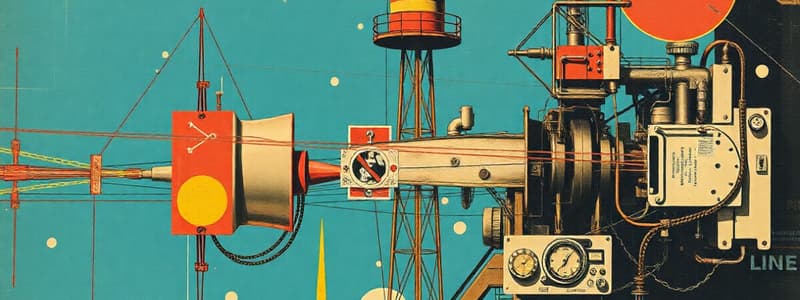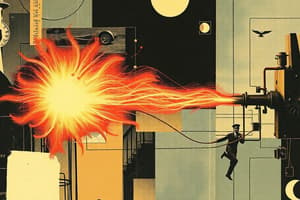Podcast
Questions and Answers
What is the equation for kinetic energy?
What is the equation for kinetic energy?
K.E. = 1/2 m v^2
What is the equation for elastic potential energy?
What is the equation for elastic potential energy?
Elastic potential energy = 0.5 × spring constant × (extension)^2
What is the equation for gravitational potential energy?
What is the equation for gravitational potential energy?
E = m x g x h
What energy transfers occur as a person throws a ball up in the air, and it falls back down?
What energy transfers occur as a person throws a ball up in the air, and it falls back down?
How are 'work done' and 'energy transferred' linked?
How are 'work done' and 'energy transferred' linked?
What are the units for work done?
What are the units for work done?
Convert 250cm into m.
Convert 250cm into m.
Which is the correct equation for force?
(Rearrange W = F x s)
Which is the correct equation for force? (Rearrange W = F x s)
What is the work done when a weightlifter uses a force of 20N to lift a weight of 50kg?
What is the work done when a weightlifter uses a force of 20N to lift a weight of 50kg?
A cyclist accelerates from a set of lights. The driving force of the back tyre on the ground is 250N. How much work is done when the cyclist travels 5m?
A cyclist accelerates from a set of lights. The driving force of the back tyre on the ground is 250N. How much work is done when the cyclist travels 5m?
Flashcards
What is 'work' in science?
What is 'work' in science?
In science, 'work' refers to the transfer of energy that occurs when a force causes an object to move a certain distance.
What is the relationship between 'work' and 'energy'?
What is the relationship between 'work' and 'energy'?
The amount of energy transferred to an object when work is done on it.
What is the equation for calculating work done?
What is the equation for calculating work done?
Work done (W) is calculated by multiplying the force (F) applied to an object by the distance (s) the object moves in the direction of the force. W = F x s
What are the units of measurement for work done?
What are the units of measurement for work done?
Signup and view all the flashcards
How is work done related to energy transfer?
How is work done related to energy transfer?
Signup and view all the flashcards
What is the relationship between energy transferred and work done?
What is the relationship between energy transferred and work done?
Signup and view all the flashcards
What is the important condition for work to be done?
What is the important condition for work to be done?
Signup and view all the flashcards
What happens when work is done against friction?
What happens when work is done against friction?
Signup and view all the flashcards
What is the equation for kinetic energy?
What is the equation for kinetic energy?
Signup and view all the flashcards
What is the equation for elastic potential energy?
What is the equation for elastic potential energy?
Signup and view all the flashcards
What is the equation for gravitational potential energy?
What is the equation for gravitational potential energy?
Signup and view all the flashcards
What energy transfers occur when a person throws a ball up and it falls back down?
What energy transfers occur when a person throws a ball up and it falls back down?
Signup and view all the flashcards
Study Notes
Learning Intentions and Success Criteria
- To understand and calculate work done by a force.
- Success criteria include explaining work in science, linking work and energy, and calculating work done by a force.
Key Words
- Work
- Energy
- Distance
- Force
Equations
- Kinetic Energy (KE): KE = 1/2 * m * v² (where m = mass and v = velocity)
- Gravitational Potential Energy (GPE): E = m * g * h (where m = mass, g = gravitational field strength, and h = height)
- Elastic Potential Energy: 0.5 * spring constant * (extension)²
- Work Done: W = F * s (where W = work done, F = force, and s = distance moved in the direction of the force)
Energy Transfers
- Work is done to overcome friction, transferring energy as heat.
- Energy transfers from kinetic energy to thermal energy when brakes are applied.
- Work is fundamental to energy transfer.
Units
- Work done is measured in Joules (J).
- Force is measured in Newtons (N).
- Distance is measured in metres (m).
Example Calculation
- A cyclist uses a constant braking force of 140 N to stop his bicycle in a distance of 24 m. Calculate the work done.
- Work done = 140 N * 24 m = 3360 J
Further Points
- Work is done when a force moves an object.
- Energy is transferred to the object.
- The energy transferred is equal to the work done.
- The base units for measurements include:
- Temperature (°C)
- Mass (kg)
- Pressure (Pa)
- Force (N)
- Volume (m³)
- Distance (m)
Knowledge Check and Questions
- How are 'work done' and 'energy transferred' linked? They are equal.
- What are the units for work done? Joules (J).
- Convert 250 cm to m: 0.25 m
- Which is the correct equation for force? Force = work done / distance.
- What is the work done when a weightlifter uses a force of 20 N to lift a weight of 50 kg?
- The question is incomplete. You need to know the distance moved by this item. This is required in the equation W=F.d
- A cyclist accelerates from a set of lights. The driving force of the back tyre on the ground is 250 N. How much work is done when the cyclist travels 5 m? 1250 J
- A worker uses a constant force of 60 N to push a box across the floor. They transfer 1680 J of energy to the box. How far have they pushed the box? 28 metres
- A worker uses a constant force of 645N to push a box across the floor. They transfer 20 kJ of energy to the box. How far have they pushed the box? 31 metres
Studying That Suits You
Use AI to generate personalized quizzes and flashcards to suit your learning preferences.




